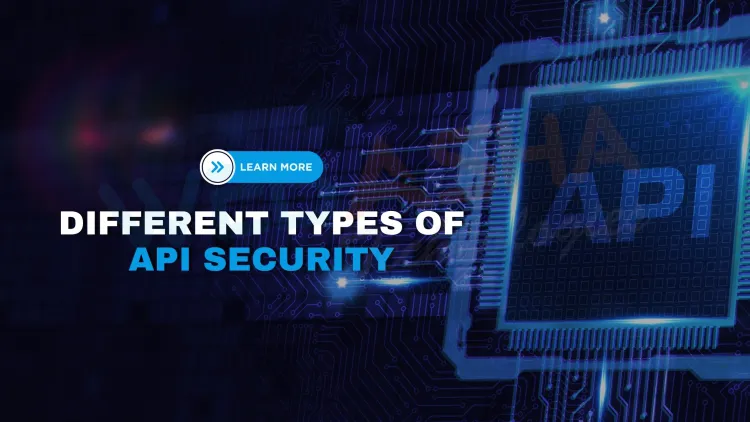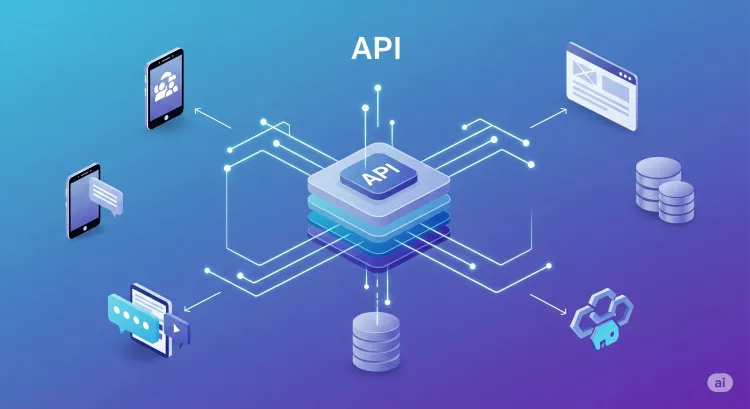What Are the Different Types of API Security? 9 Proven Ways to Protect Your APIs in 2025
API security is essential in 2025 as attackers increasingly target APIs to exploit vulnerabilities. This blog explains the most important types of API security, including OAuth2, HTTPS, WebAuthn, API Gateways, Firewalls, API Versioning, Rate Limiting, Authorization, and Input Validation. Each security method is described with practical steps to help developers and organizations protect sensitive data, prevent unauthorized access, and secure API ecosystems against evolving cyber threats.

Table of Contents
- Why Is API Security Critical in 2025?
- 9 Essential Types of API Security You Should Know
- OAuth2 – Secure Authentication and Delegated Access
- HTTPS – Encrypt Data in Transit
- WebAuthn – Strong Client Authentication
- API Gateway – Centralized Traffic and Security Control
- Firewall – Protect Against Malicious Traffic
- API Versioning – Secure API Lifecycle Management
- Rate Limiting – Prevent Abuse and DDoS
- Authorization – Role and Attribute-Based Access Control
- Input Validation – Stop Injection Attacks
- Conclusion
- Frequently Asked Questions (FAQs)
In today’s digital ecosystem, APIs (Application Programming Interfaces) have become essential to power web apps, mobile apps, and IoT devices. From online banking to e-commerce platforms, APIs enable seamless data exchange. But as their usage grows, so does their vulnerability.
API attacks have surged in 2025, from token theft to injection attacks. This blog covers the key types of API security methods that protect APIs from modern threats, along with practical explanations for each technique.
Why Is API Security Critical in 2025?
APIs are often directly exposed to the internet, making them a frequent target for:
-
Credential stuffing attacks
-
Data exposure and leaks
-
Injection attacks (SQLi, XSS, etc.)
-
Distributed Denial-of-Service (DDoS) attacks
A strong API security posture ensures data privacy, integrity, and system availability.

9 Essential Types of API Security You Should Know
Here’s a detailed breakdown of the most important API security mechanisms organizations should implement:
| Security Type | Purpose | How It Helps Protect APIs |
|---|---|---|
| OAuth2 | Secure user authentication & delegated access | Protects against unauthorized access and token misuse |
| HTTPS | Encrypt data in transit | Prevents man-in-the-middle (MITM) attacks and eavesdropping |
| WebAuthn | Strengthen client and browser authentication | Adds phishing-resistant multi-factor authentication (MFA) |
| API Gateway | Centralized API traffic management | Filters, monitors, and secures all API calls from one place |
| Firewall | Block malicious traffic | Protects APIs from DDoS and injection attacks |
| API Versioning | Manage API changes securely | Reduces security gaps when updating or deprecating APIs |
| Rate Limiting | Control traffic volume | Prevents brute-force and DoS attacks by throttling API requests |
| Authorization | Enforce strict role-based or attribute-based access | Ensures users can only access permitted resources |
| Input Validation | Validate incoming data | Blocks injection attacks and malformed requests |
OAuth2 – Secure Authentication and Delegated Access
OAuth2 is a widely used protocol for user authorization. It allows third-party apps to access user data without sharing passwords.
-
Protects sensitive resources through access tokens
-
Helps prevent token theft and replay attacks
-
Used in services like Google, Facebook, and Microsoft APIs
✅ Pro Tip: Use short-lived access tokens with refresh tokens to enhance security.
HTTPS – Encrypt Data in Transit
Using HTTPS ensures all communication between the client and server is encrypted.
-
Protects API payloads from interception
-
Prevents session hijacking
-
Essential for regulatory compliance (e.g., GDPR, HIPAA)
✅ Pro Tip: Enforce HTTP Strict Transport Security (HSTS) for API endpoints.
WebAuthn – Strong Client Authentication
WebAuthn (Web Authentication) uses public-key cryptography for passwordless logins.
-
Resists phishing and credential theft
-
Works with biometric authentication and security keys
-
Ideal for sensitive API endpoints requiring strong authentication
✅ Pro Tip: Integrate WebAuthn with OAuth2 flows for maximum protection.
API Gateway – Centralized Traffic and Security Control
An API Gateway acts as a single entry point for managing API traffic.
-
Enforces authentication and authorization
-
Manages load balancing, caching, and rate limiting
-
Monitors and logs API requests for anomaly detection
✅ Pro Tip: Use solutions like AWS API Gateway, Kong, or Apigee for robust API management.
Firewall – Protect Against Malicious Traffic
Firewalls (WAF and network firewalls) filter harmful API traffic.
-
Blocks SQL injection, XSS, CSRF attacks
-
Provides DDoS protection
-
Works in conjunction with API gateways
✅ Pro Tip: Deploy both WAF (Web Application Firewall) and traditional network firewalls for layered defense.
API Versioning – Secure API Lifecycle Management
When updating APIs, changes can introduce security vulnerabilities. API versioning helps:
-
Manage backward compatibility
-
Control access to deprecated or vulnerable API versions
-
Reduce accidental exposure of outdated endpoints
✅ Pro Tip: Deprecate old API versions with proper notifications to clients.
Rate Limiting – Prevent Abuse and DDoS
Rate limiting controls how often a client can call an API within a set time window.
-
Protects against brute-force attacks
-
Reduces server overload from bots or malicious actors
-
Helps enforce fair usage policies
✅ Pro Tip: Use token bucket or leaky bucket algorithms for flexible rate limiting.
Authorization – Role and Attribute-Based Access Control
Authorization defines what authenticated users are allowed to do.
-
Role-Based Access Control (RBAC): Assigns permissions based on user roles
-
Attribute-Based Access Control (ABAC): Uses attributes like location or device type
✅ Pro Tip: Never rely on client-side authorization alone. Always enforce rules server-side.
Input Validation – Stop Injection Attacks
Input validation ensures only correctly formatted and safe data enters your API.
-
Blocks SQL injection, command injection, and similar threats
-
Prevents unexpected crashes or data corruption
-
Validates both query parameters and request bodies
✅ Pro Tip: Use strict JSON schemas and sanitization libraries.
Conclusion
In 2025, API security is non-negotiable. With cyberattacks targeting APIs increasing rapidly, relying on just one protection method isn’t enough. A layered security strategy incorporating all nine techniques discussed here provides the best defense against modern threats.
If your organization depends on APIs, start by assessing your current security setup. Implement missing protections and continuously monitor your API landscape for new vulnerabilities.
FAQs
What is API security?
API security is the practice of protecting application programming interfaces (APIs) from unauthorized access, data breaches, and cyberattacks using various security techniques and frameworks.
Why is API security important in 2025?
With the growing use of APIs in apps and services, attackers increasingly target them. API security helps protect sensitive data, maintain system integrity, and prevent business disruptions.
What are the types of API security?
Common types include OAuth2, HTTPS, WebAuthn, API Gateway, Firewall, API Versioning, Rate Limiting, Authorization, and Input Validation.
How does OAuth2 secure APIs?
OAuth2 secures APIs by handling secure user authentication and delegated access through access tokens, reducing the need to share passwords directly.
What role does HTTPS play in API security?
HTTPS encrypts data transmitted between the client and the server, preventing attackers from intercepting sensitive information.
What is WebAuthn in API security?
WebAuthn is a passwordless authentication method using public-key cryptography, enhancing API security by resisting phishing and credential theft.
What is an API Gateway?
An API Gateway is a management layer that controls API traffic, enforces security policies, and protects against unauthorized access and attacks.
How do firewalls protect APIs?
Firewalls filter and block malicious traffic targeting APIs, defending against injection attacks, DDoS attacks, and unauthorized access attempts.
Why is API versioning important?
API versioning helps manage updates and changes securely without breaking existing services or exposing outdated and vulnerable endpoints.
How does rate limiting improve API security?
Rate limiting prevents abuse and denial-of-service (DoS) attacks by controlling how many requests a user or system can make in a given time.
What is authorization in API security?
Authorization ensures that authenticated users only access the resources and actions they’re allowed to, using role-based or attribute-based access control.
What is input validation for APIs?
Input validation checks incoming data for correctness and safety, preventing attacks like SQL injection and cross-site scripting (XSS).
Can APIs be protected using multi-factor authentication?
Yes, integrating multi-factor authentication (MFA) adds an extra layer of protection, ensuring only verified users can access sensitive API functions.
What is the difference between authentication and authorization in APIs?
Authentication confirms a user’s identity, while authorization defines what actions that user can perform within the API system.
How do hackers attack APIs?
Hackers target APIs through injection attacks, credential stuffing, token theft, brute force, DoS attacks, and exploiting misconfigurations.
What tools are used for API security testing?
Popular tools include OWASP ZAP, Postman Security Audit, Burp Suite, and APIsec for scanning and securing APIs.
How does API token management work?
API token management involves issuing, storing, rotating, and revoking API tokens securely to prevent unauthorized access.
Why should APIs be monitored continuously?
Continuous monitoring helps detect unusual activity, potential breaches, and performance issues before they escalate into major problems.
What is API throttling?
API throttling limits the number of requests from a user or application to control traffic and prevent system overload or abuse.
How do API keys differ from OAuth tokens?
API keys provide basic access control and are static, while OAuth tokens offer dynamic, more secure access with expiration times and scopes.
Should sensitive data be transmitted via APIs?
Sensitive data can be transmitted via APIs if encryption (HTTPS) and proper authorization mechanisms are in place to protect it.
What is zero trust security for APIs?
Zero trust security assumes no user or device is trusted by default and requires continuous verification and strict access control for every API request.
How does caching affect API security?
Improper caching can expose sensitive data. Configuring secure cache headers ensures sensitive responses aren’t cached where unauthorized users can access them.
What is Cross-Origin Resource Sharing (CORS) in API security?
CORS controls which domains can access APIs, preventing unauthorized sites from making API requests on behalf of a user.
How often should API security be tested?
Regular security testing, at least quarterly or after major updates, is recommended to keep APIs secure against new vulnerabilities.
What is API whitelisting?
API whitelisting restricts access to APIs only to approved IP addresses, applications, or users, enhancing security.
Can machine learning help in API security?
Yes, machine learning can detect abnormal API behavior and potential threats faster through anomaly detection models.
How does JSON Web Token (JWT) fit into API security?
JWTs securely transmit information between parties as JSON objects and are often used in authentication and authorization within APIs.
What is an API security gateway?
An API security gateway combines API management with security controls such as encryption, authentication, rate limiting, and monitoring.
How does cloud security affect API security?
Cloud environments require additional API security controls, including encryption, access management, and compliance with cloud service provider policies.
What are the common mistakes in API security?
Common mistakes include exposing sensitive endpoints, weak authentication, lack of rate limiting, and improper input validation.














![Top 10 Ethical Hackers in the World [2025]](https://www.webasha.com/blog/uploads/images/202408/image_100x75_66c2f983c207b.webp)








